
When we planned our trip to Saudi Arabia, we had plenty of questions. How would it be to travel as two women? Would we be able to eat in restaurants without a man accompanying us? And what about vegetarian food in Saudi Arabia – would we find anything beyond hummus and bread?
We spent almost four weeks travelling through the country, and the vegetarian food surprised us. Eating out was easier than expected, and people were welcoming and curious. Most of all, we discovered that vegetarian food in Saudi Arabia is more varied and flavourful than we imagined.
Eating out as foreign women at a Saudi restaurant
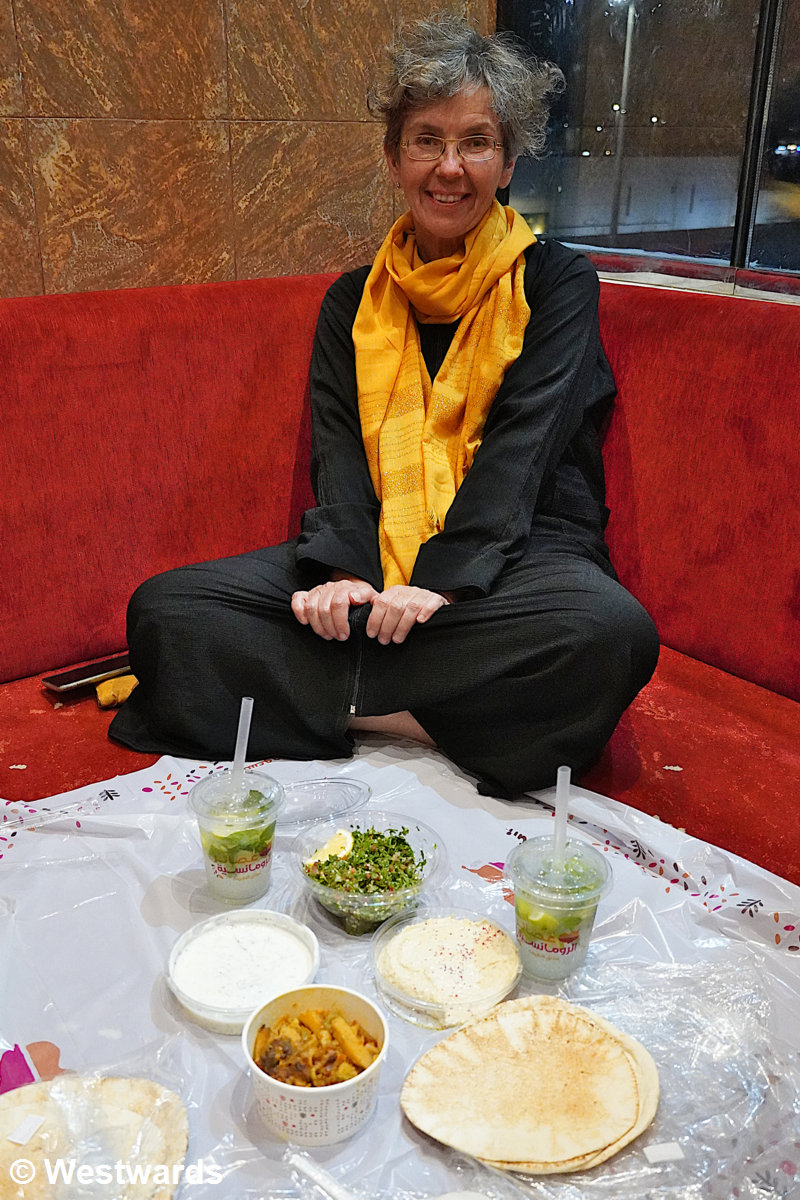
In Medina, we took a taxi to get to Al Romansiah, a popular Saudi restaurant. That was because although it looked deceptively close to our hotel, huge motorways prevented us from walking there. Behind the entrance we passed the busy take-away counters and were sent upstairs. The first floor was men-only: Rows of open tables filled with male chatter and the aroma of grilled rice dishes. The next floor was the family section – with numbered compartments of different sizes along a corridor. Inside we found red velvet carpets, cushions, and no table. It was a space to sit cross-legged on the floor and eat in private.

Some of the compartments were big enough for groups of 10 or 20 people, but being just the two of us, we only claimed a tiny room of about 3 or 4 square meters. We dropped our bags and walked back to the reception counter to order food. Normally one of the men would do this for the whole family, but being on our own, we did order ourselves. Quite possibly this felt awkward for the (male) staff who were not used to dealing with women. And even these curious foreigners who did not know the dishes and asked so many questions …
The heavily curtained doors mean that the women can take off their headscarves while one of the men accepts the food delivered outside the room. Obviously, we had to wait until all the food was delivered before we could relax and remove our head scarves.
Altogether it was a quiet, somewhat isolating meal, and we found ourselves wishing for a bit more interaction. Still, it was an interesting glimpse into how families dine in Saudi restaurants – and another step into understanding Saudi culture.
Vegetarian food in Saudi restaurants

Most national dishes are all about meat – camel, chicken, lamb, and endless kinds of kebabs. As vegetarians, that meant we didn’t eat in traditional Saudi restaurants very often. However, there were some vegetarian options that we enjoyed.
One of our go-to orders was a dish simply called “mixed vegetables”. It was exactly that: some grilled vegetables, along with rather dry potatoes and plenty of spices. Not fancy, but nevertheless satisfying after a long day of driving and sightseeing.
We also relied on the familiar comfort of the middle eastern appetizers, including creamy hummus, fresh salads, warm flat bread, and zesty tabbouleh. Among the more elaborate meze were stuffed baby aubergines and different types of bread.
Vegetarian food in Saudi Arabian restaurants might not take center stage, but there’s always something to discover on the menu.
Typical vegetarian dishes in international restaurants in Saudi Arabia
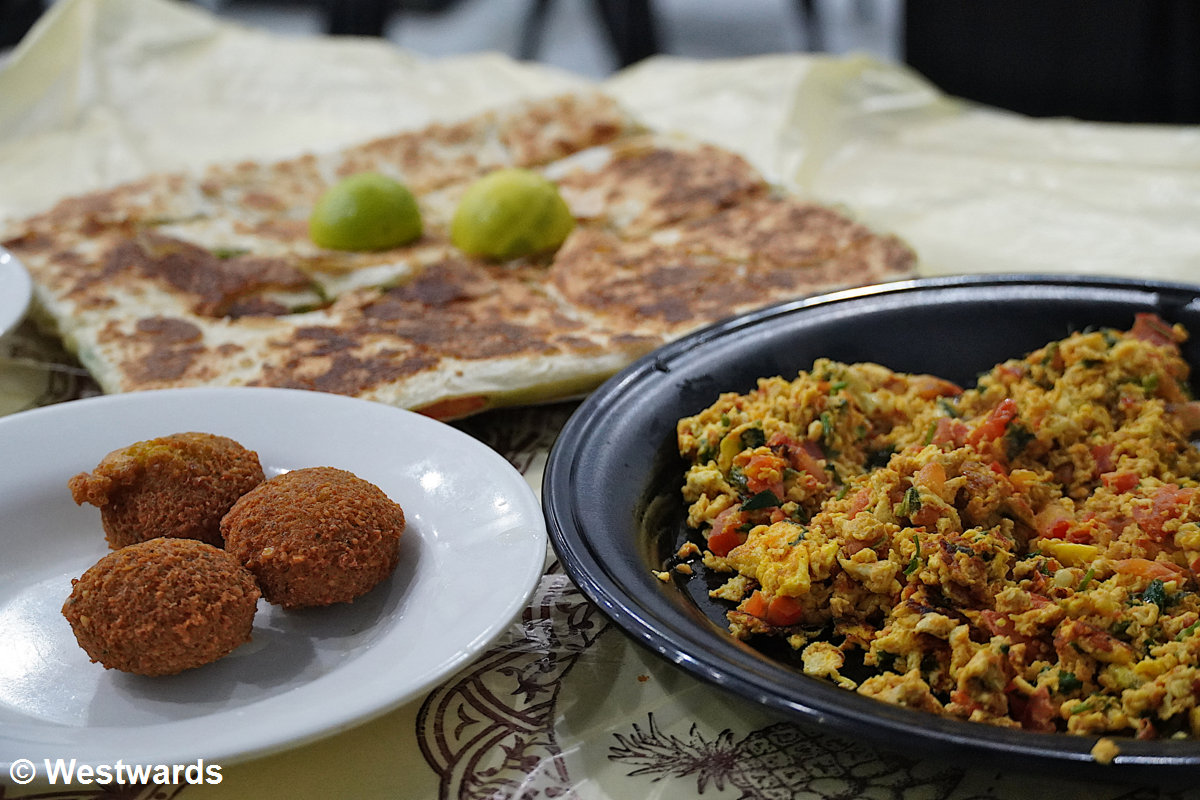
We ended up eating more often in foreign restaurants than in traditional Saudi ones. Firstly, the secluded seating arrangements in Saudi restaurants felt isolating. Don’t you also go out for dinner in order to see other people? Second, vegetarian options were easier to find elsewhere. And third, foreign eateries were everywhere – from motorway rest areas to bustling highstreets. Most of these restaurants reflected the countries of Saudi Arabia’s guest workers: offering Pakistani, Afghani, Indian, Egyptian, or Indonesian cuisine.
Flaky flatbreads like Fatteer, Pathoray, or Paratha quickly became a vegetarian staple for us. We also had a similar dish called Murtabal or Murtabak: a bread-like pancake with a vegetable filling. In Al Ula we liked the Murtabal Khadaal in the nearby restaurant so much that we came back to eat it several times. It was filled with green herbs, similar to Zhingalov Hats in Armenia or Kuku Sabzi in Iran. Manakish, the thin flatbread baked with oil and za’atar was another good option.

Egyptian restaurants offered comfort in the form of Kushari, one of our favourite vegetarian dishes. And Indian restaurants served fresh Thalis, golden Samosas, tasty Dhals and soft naan bread. In Afghan restaurants we discovered Ads, a spicy lentil soup – also very tasty!
In the simple eateries run by immigrants, nobody cared if we sat in the main room although we were sometimes the only women. Staff and fellow guests were generally welcoming and courteous. These restaurants sometimes had partition screens for those women who wanted to take off their headscarf or niqab for eating. Eating in these international restaurants reminded us how a country’s food culture is shaped not only by local traditions, but also by the diverse communities that call the place their home.
Fast food stalls

Saudi Arabia has its share of fast-food chains and street stalls, which sometimes made for an easy quick meal. Vegetarian options were limited, though: for example, there weren’t any vegetarian burgers on the menu. However, we did find tasty alternatives like ful. We often went for a simple sandwich with egg and cheese, sometimes paired with fries. This wasn’t exactly gourmet dining, but it was convenient and filling.
Delivery service and eating in our hotel room
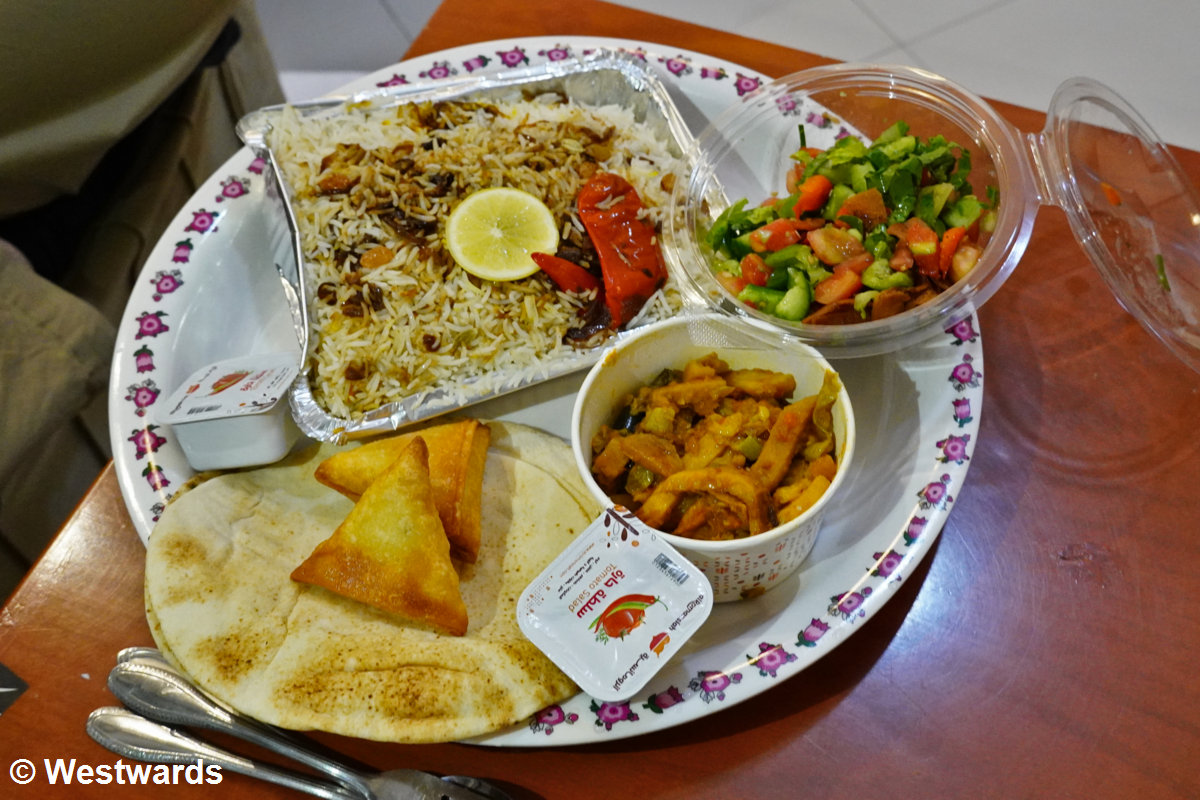
Room rates were usually without breakfast, and thus eating breakfast in our hotel room became a routine. We usually prepared muesli with fruit and yoghurt and some oat flakes. We also sometimes bought piles of fresh fruit for dinner, enjoying them with some more rich yoghurt. Fresh pomegranates were a particular favourite. We also picked up bread, ready-made salads, cheese and hummus from the supermarket whenever we wanted something simple and fresh.
Not every meal was a hit. Once we ordered a take-away pizza that resembled a cheese pide with ketchup, and some more extra ketchup. And for once we would have happily paired it with a glass of red wine to make it more palatable. (Otherwise, we didn’t miss the wine)
More often, though, we relied on the local delivery app, Hunger Station. Especially when getting to a restaurant would have meant driving again! Having the food delivered straight to our hotel room was perfectly normal and we were pleasantly surprised by how easy it was to find vegetarian options.
Delivery thus became a convenient and tasty way to enjoy vegetarian food in Saudi Arabia without leaving the comfort of our room.
Sweet filling breakfasts

Sometimes breakfast was included in the room fee, or we prepared it ourselves in the hotel room. But we also went out to have breakfast – either because we didn’t manage to buy fruit and yoghurt the day before, or because we spotted a tempting breakfast option. In Jeddah, for example, we went out of our way for a lush western breakfast at Ext. Seventeen, a fancy restaurant serving pancakes and French toasts. It was sooo good!
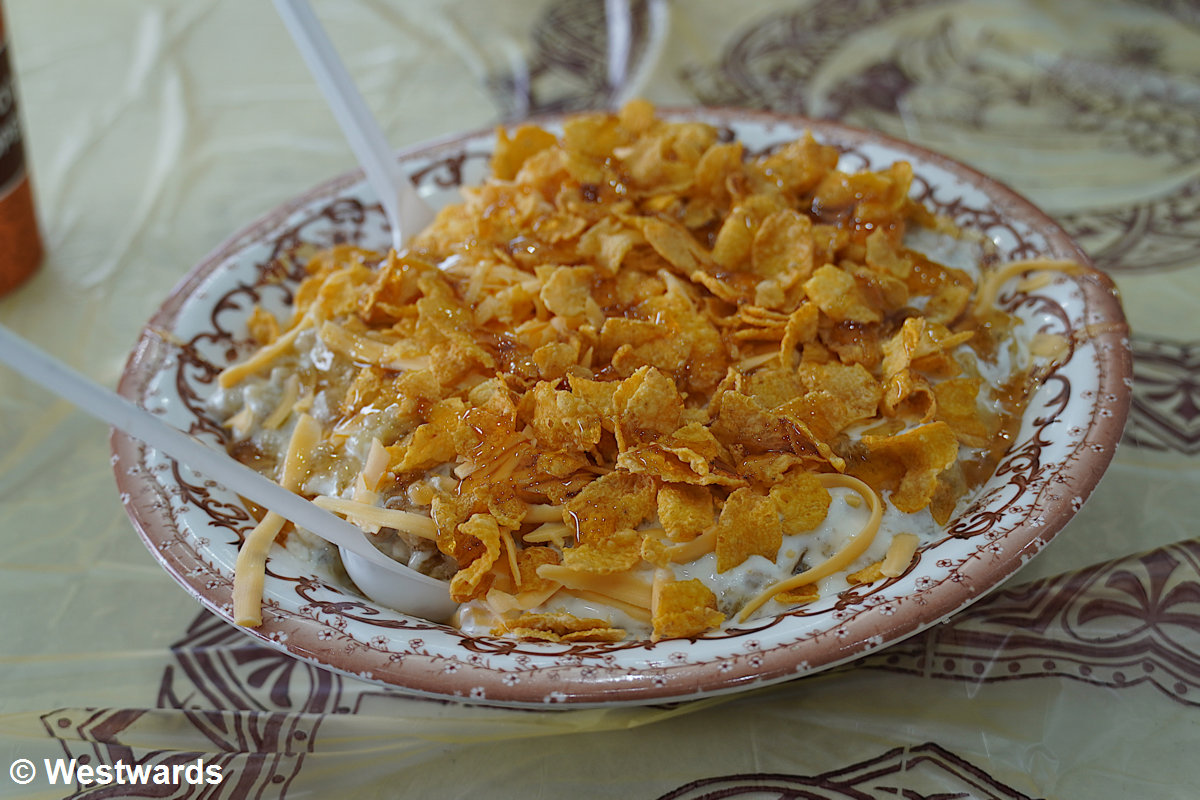
We also explored local options, like Masoub, a breakfast porridge from Yemen. It consists of grains cooked in milk and cream, garnished with cheddar cheese and cornflakes. Sounds weird? But it was very tasty and pleasantly (but not overly) sweet. Arika is a similar breakfast mash made from bread, enriched with cream and nuts and also topped with cornflakes for crunch. Both, Masoub and Arika, were very filling: Even sharing a portion between the two of us left us full for hours. We guess these breakfast dishes were originally intended for manual labourers …
Sweet Delights
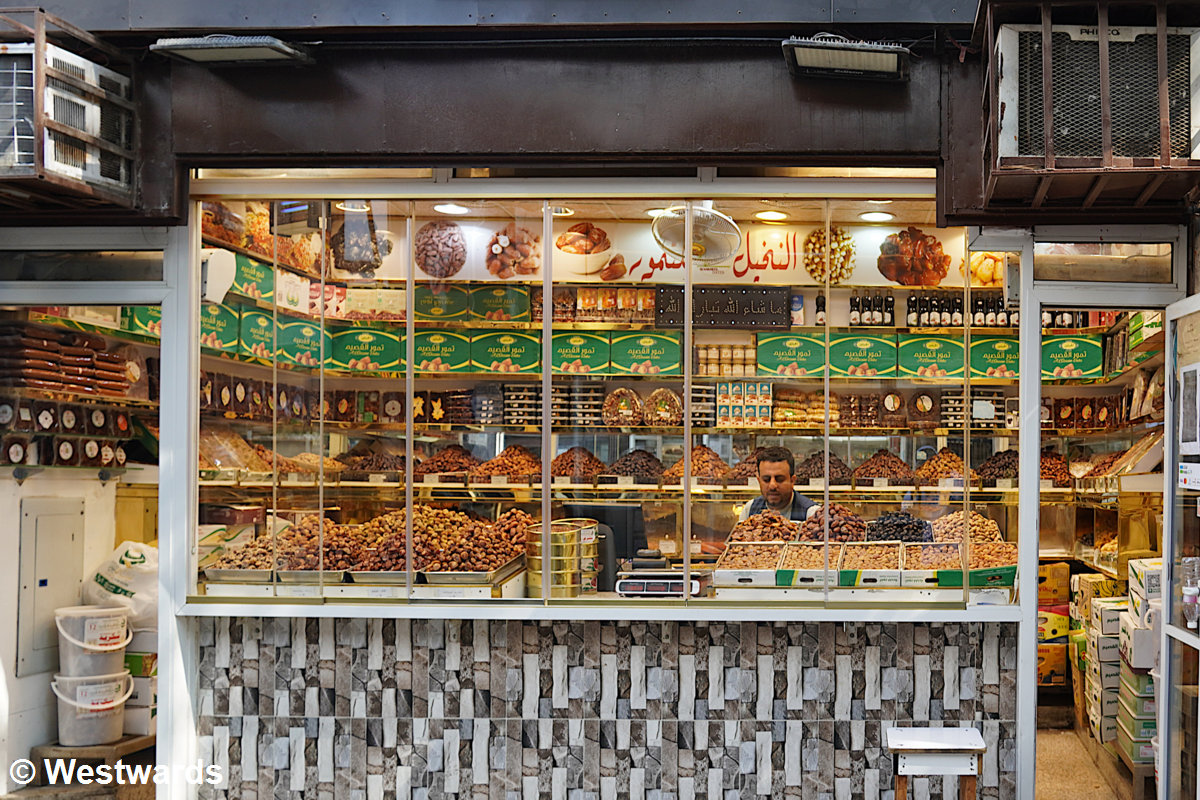
Different kinds of dates form a cornerstone of what the Saudis call “Hospitality”. Whenever you enter a facility as a guest – a hotel, for instance – the host offers you a small treat. Invariably, this includes a tiny cup of heavily spiced coffee – the Saudi Coffee – and a fresh date. Dates are available in dozens of varieties, and people have clear preferences which types they like best. The most luxurious versions are stuffed with nuts and pistachios, resembling small, fancy pralines or chocolate truffles. Of course they are priced accordingly.
Beyond dates, sweet desserts are also popular in the Arab tradition, as we know well from our travels in Egypt, Qatar and Morocco.
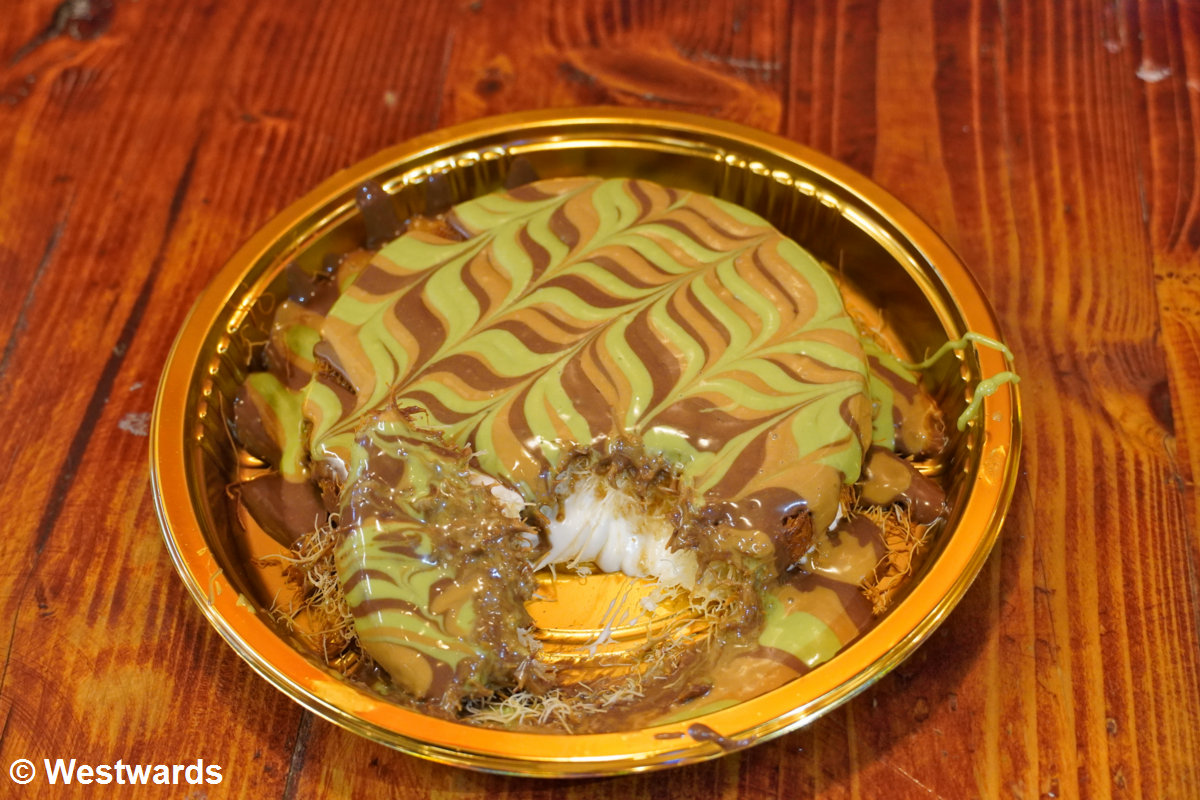
Many of these include pistachios. And in Saudi Arabia we tried everything pistachio: from French toast smothered in pistachio paste to, our absolute favourite, Kunafa with pistachio cream. We first fell for Kunafa during a month in Damascus in 2007. Crunchy kadayif (the stuff that’s in Dubai chocolate) layered with soft, sweetish cheese, and sticky honey or syrup! In Saudi Arabia some pastry shops take it even further, combining the Kunafa with Nutella or a rich pistachio cream for extra indulgence.
Drinks beyond tea and water
Alcohol is not available in Saudi Arabia – at least not to visitors like us – so we focused on exploring the many other beverages on offer.
The strangest drink we had was Sobia, a barley-based drink flavoured with cinnamon and cardamom. “It’s healthy”, a local woman remarks, recalling how for her, it tastes of childhood.
“Maybe you’ll need a while to get to like it …”
We agree with that – somehow the concoction is too sweet and strangely enough at the same time too bitter.
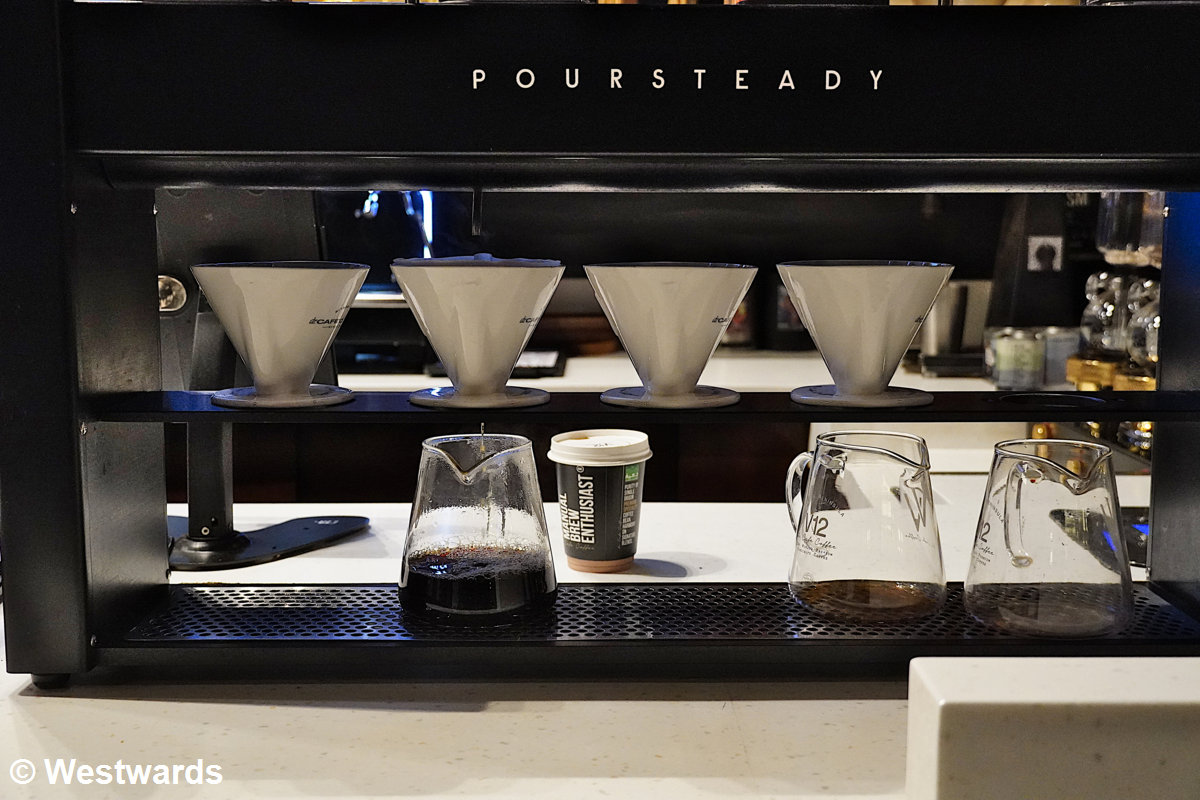
To our surprise, we found a lot of excellent speciality coffee in the Kingdom of Saudi Arabia. Perhaps, in a culture without alcohol, coffee takes on the role of a connoisseur’s hobby, much like craft beer or rare whiskys elsewhere. Local roasteries offered carefully sourced beans and expertly brewed coffee. Though it was sometimes roasted a bit darker than we prefer. Among our favourites were Ratio Coffee in Sakaka and several roasteries in Riyadh, including Dr. Café, Toby’s Estate (an Australian chain), and Camel Step. In Jeddah, Caffeine Lab even served speciality coffee grown in Saudi Arabia itself.
Fancy coffee shops like these as a rule had no gender-segregated areas (although some offered a prayer room), and women kept their headscarves on.
Is Saudi Arabia a good country for vegetarian travellers?

Surprisingly, yes — more than we expected. While traditional Saudi cuisine is very meat-heavy, vegetarian travellers can still eat well thanks to the country’s diversity. The many Indian, Pakistani, Egyptian, and Afghan restaurants offer plenty of flavourful vegetarian dishes at affordable prices.
Local Saudi restaurants are interesting for the cultural experience but not the easiest for vegetarians – or for women travelling alone. Still, with international eateries, good coffee, fresh fruit, and reliable delivery apps, finding satisfying vegetarian food in Saudi Arabia is quite easy.
In short: Saudi Arabia may not be a vegetarian paradise, but it’s definitely a rewarding destination for open-minded travellers who enjoy exploring the local food scene.
NB: We were not sponsored in any way to write this blog post and we paid for all the food ourselves.
Never miss a new post! Get notifications about new posts straight into your inbox!
Use this image to save to Pinterest:

